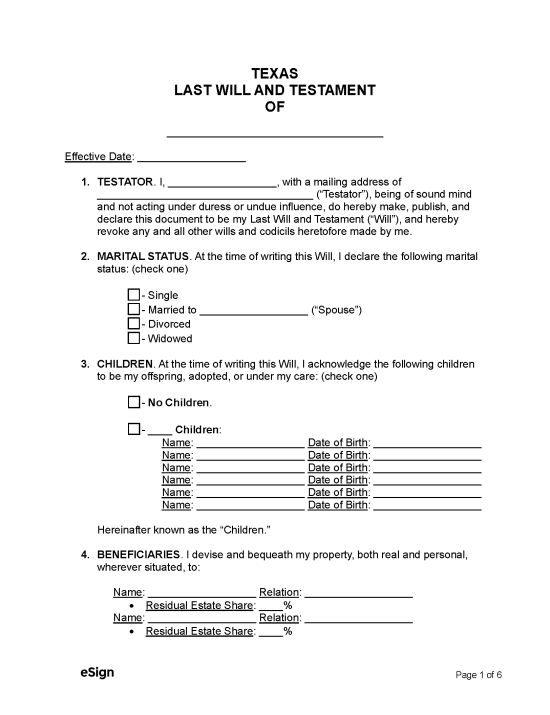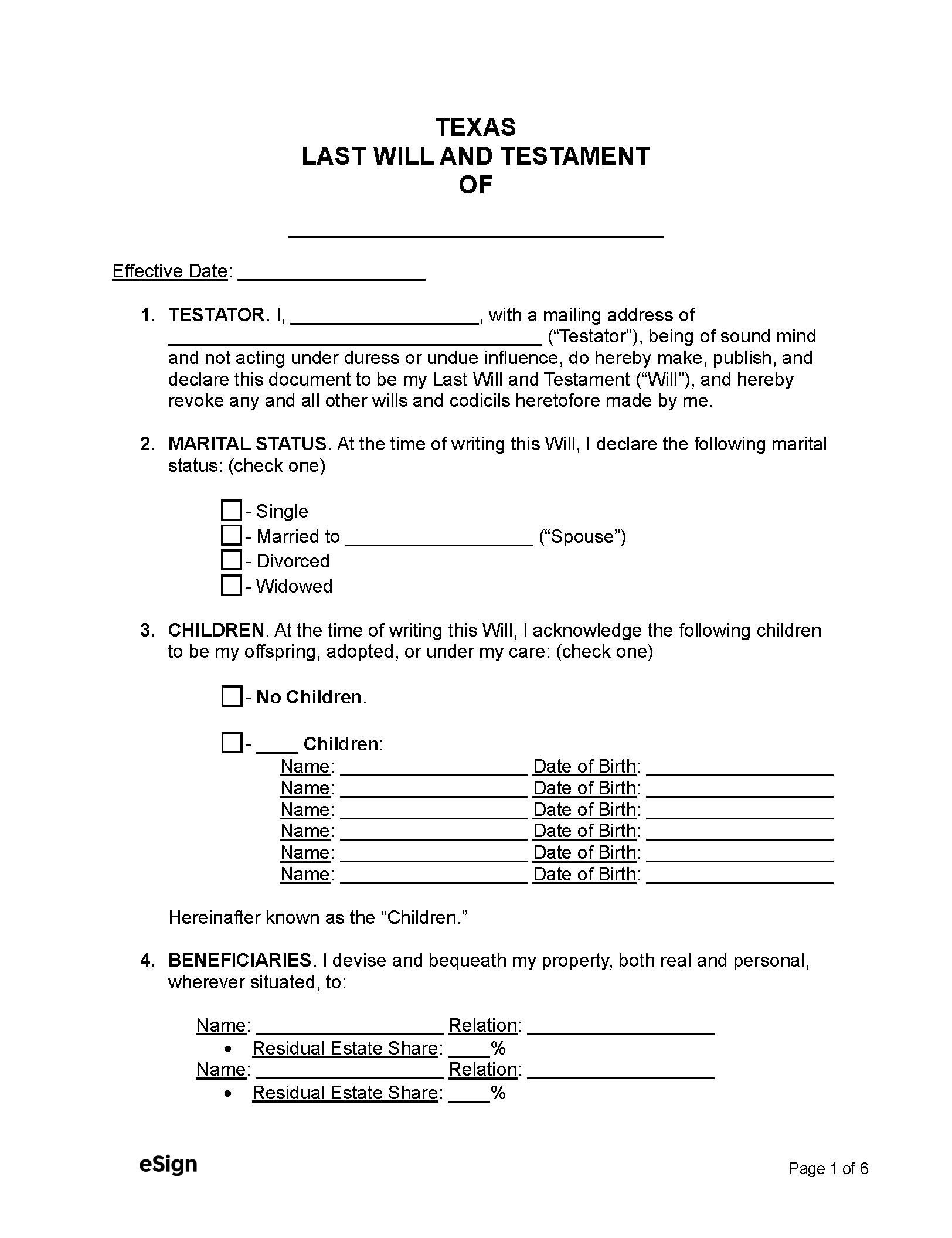State Laws
A will may be executed by any adult who is at least 18 years old and of sound mind.[1]
Holographic Wills – A handwritten, unwitnessed will is permissible as long as it’s entirely in the testator’s handwriting.[2]
Revocation – A will may be revoked if a subsequent one is executed or the original document is physically destroyed.[3]
Signing Requirements – The will must be signed by the testator or someone under their direction and two witnesses.[4]
Probate Process in Texas (9 Steps)
Texas law requires that probate must be applied for within four years of the testator’s death.[5]
- Apply for Probate
- Notice and Hearing
- Executor Oath
- Post Bond (If Applicable)
- Letters Testamentary
- Notice to Creditors
- Notice to Beneficiaries
- Estate Inventory
- Pay Taxes and Debts
- Close the Estate
1. Apply for Probate
An estate valued at $75,000 or less with no real estate can potentially bypass probate if the petitioner files a Small Estate Affidavit.[6]
In most cases, the executor named in the will shall initiate probate proceedings. However, any interested party may apply to open probate.[7]
An Application for Probate of Will and Issuance of Letters Testamentary must be filed with the county clerk in the county where the decedent was living before death.[8]
The applicant will also need to file the original will with the clerk along with a Civil Case Information Sheet.[9]
Probate may be “independent” or “dependent” in Texas. Dependent administration requires court approval for most actions, while independent administration gives the executor or personal representative more autonomy. Independent administration is allowed if the will specifies it or all beneficiaries agree to it.
2. Notice and Hearing
After the Application for Probate of Will has been filed, the county clerk will post a public notice at the courthouse, giving the opportunity for anyone to object to the application.[10] After a minimum 10-day waiting period following the posting of the notice, a hearing may take place to determine if the will may be admitted to probate.[11]
Before the hearing, the executor should prepare a Proof of Death Testimony, which states that the testator has passed away, that the court has jurisdiction over the probate, and that the executor is legally qualified to carry out their duties.[12] The executor will need to obtain and file a copy of the Death Certificate, which may be acquired via the Texas Department of State and Health Services website.
At the hearing, the executor will need to prove the validity of the will. If the will is self-proving, the executor may give testimony to confirm its validity. Otherwise, witnesses will be called to testify.[13]
If the judge is satisfied that the will is authentic and that the executor is fit to carry out their duties, they will sign a Decree Admitting Will to Probate (Harris County SAMPLE).[14]
3. Executor Oath
Once the judge approves the Application for Letters Testamentary, the executor must take an oath that states that they will carry out their duties to the best of their ability on behalf of the estate.[15] Harris County provides a sample of the Oath of Executor.
4. Post Bond (If Applicable)
A probate bond may need to be posted before the court will issue Letters Testamentary.[16] Probate bonds are used to protect beneficiaries and creditors from any mistakes or wrongdoing by the executor. In many cases, the will often includes a provision waiving the necessity for a bond.
6. Notice to Creditors
Within 30 days of appointment, the executor will need to publish a Notice to Creditors and Publishers Affidavit (SAMPLE) in a local newspaper.[17] This notice gives creditors an opportunity to make any claims against the estate. The Publisher’s Affidavit must then be filed with the court.
The executor will have two months to send written notice of Letters Testamentary to any creditors with a claim against any real property of the estate.[18] A copy of any notice sent to creditors with proof of delivery must be filed with the court, along with an affidavit stating the notice was sent and to whom it was sent.
7. Notice to Beneficiaries
Within 60 days of being granted Letters Testamentary, the executor must notify all known beneficiaries of the probate of the will.[19] The beneficiaries will receive[20]:
- Information about the executor and the decedent’s estate.
- A statement stating the will has been admitted to probate.
- A copy of the will.
- A copy of the Decree Admitting Will to Probate
Within 90 days of the court admitting the will to probate, the executor will need to file an Affidavit of Notice to Beneficiaries (SAMPLE) with the court.[21]
8. Estate Inventory
The executor will have a 90-day window to provide the court with a detailed Inventory and Appraisement (Harris County SAMPLE) of the decedent’s estate.[22] This document catalogs all of the estate’s assets, their fair market value at the time of the decedent’s death, and the claims the estate has against other parties.
A List of Claims must also be attached to the inventory, describing who the estate is indebted to, the nature of the debt, and the amount and date due.[23]
9. Pay Taxes and Debts
The decedent’s income taxes will have to be taken care of by the executor, who will be responsible for filing a Federal Individual Income Tax Return. For larger estates, it may be required to file a United States Estate Tax Return [24] and, if the estate generates more than $600 in revenue after the date of death, a Federal Fiduciary Tax Return.
Once the executor has settled all valid claims and paid the estate taxes, they can distribute the remaining assets to the beneficiaries as detailed in the will.
10. Close the Estate
In an independent administration, the executor must file either a Notice of Closing Estate or a Closing Report with the court to close the estate.[25]
A Closing Report indicates what debts have been paid, what obligations are still owed, what property remains after paying debts, and who will get that remaining property.[26] The Report must include an affidavit by the executor and signed receipts from distributes who received any remaining property after debts were paid.
A Notice of Closing Estate will state that all known debts have been paid, all assets have been distributed, and who will get any remaining distributions after debts have been paid. A copy of the Notice must be sent to each distributee, and proof of receipt must be attached before filing with the court.[27]
If no objections are filed within 30 days of the filing, the estate will be closed, and the executor will be relieved of their duties.[28]
Sources
- § 251.001
- § 251.052
- § 253.002
- § 251.051(2)
- § 256.151(2)
- § 205.001
- § 256.051
- § 33.001
- § 256.202
- § 258.051
- § 51.053(b)
- § 301.151
- § 256.153
- § 256.201
- § 305.051
- § 305.101
- § 308.051
- § 308.053
- § 308.002
- § 308.003
- § 308.004
- § 309.051
- § 309.052
- IRS Estate Tax Threshold
- § 405.004
- § 405.005
- § 405.006
- § 405.007

